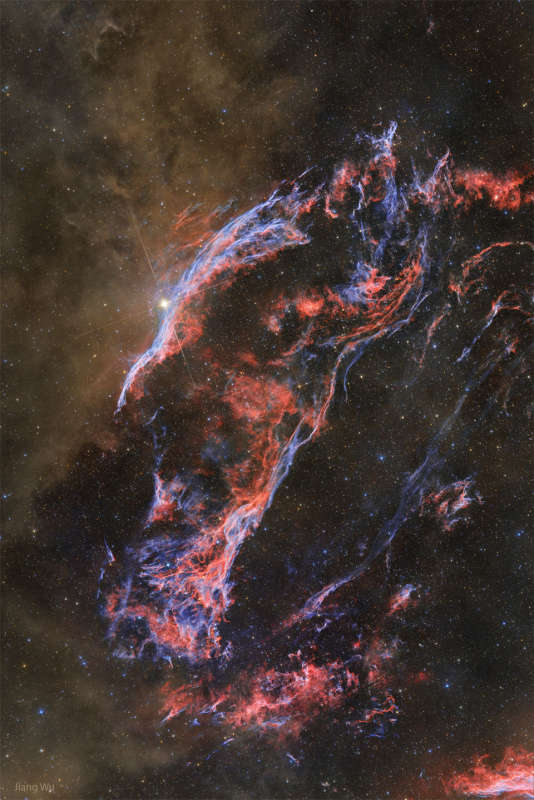Credit & Copyright: Jiang Wu
Explanation:
It's so big it is easy to miss.
The
entire Veil Nebula spans six times the diameter of the
full moon,
but is so dim you need
binoculars to see it.
The nebula was created about
15,000 years ago when a star in the
constellation of the Swan
(Cygnus) exploded.
The spectacular explosion
would have
appeared brighter than even
Venus for a week - but there is
no known record of it.
Pictured is the western edge of the still-expanding gas cloud.
Notable gas filaments include the
Witch's Broom Nebula
on the upper left near the bright foreground star
52 Cygni,
and
Fleming's Triangular Wisp
(formerly known as
Pickering's Triangle) running diagonally up the image middle.
What is rarely imaged -- but seen in the featured long exposure across many color
bands -- is the reflecting brown
dust that runs vertically up the image left,
dust likely created in the cool atmospheres of massive
stars.
1999 2000 2001 2002 2003 2004 2005 2006 2007 2008 2009 2010 2011 2012 2013 2014 2015 2016 2017 2018 2019 2020 2021 2022 2023 2024 2025 |
Yanvar' Fevral' Mart Aprel' Mai Iyun' Iyul' Avgust Sentyabr' Oktyabr' Noyabr' Dekabr' |
NASA Web Site Statements, Warnings, and Disclaimers
NASA Official: Jay Norris. Specific rights apply.
A service of: LHEA at NASA / GSFC
& Michigan Tech. U.
|
Publikacii s klyuchevymi slovami:
Veil Nebula - supernova remnant - tumannost' Vual' - ostatok Sverhnovoi
Publikacii so slovami: Veil Nebula - supernova remnant - tumannost' Vual' - ostatok Sverhnovoi | |
Sm. takzhe:
Vse publikacii na tu zhe temu >> | |
